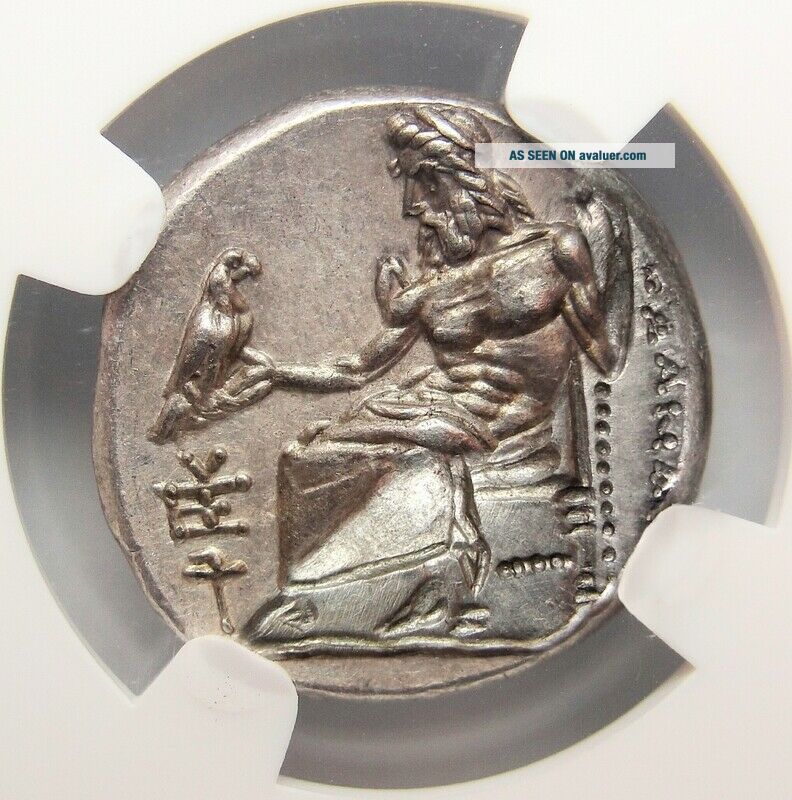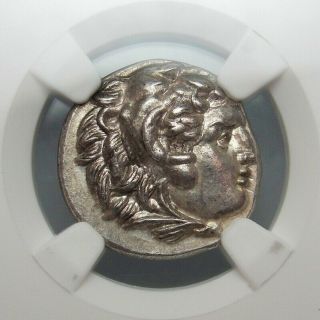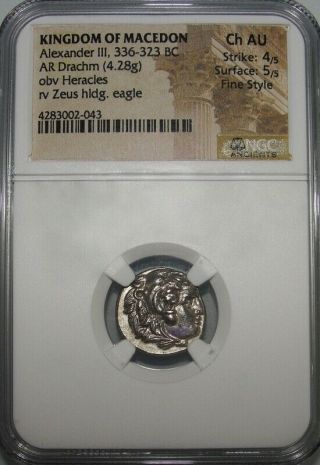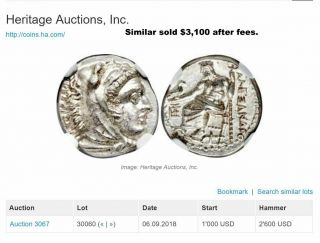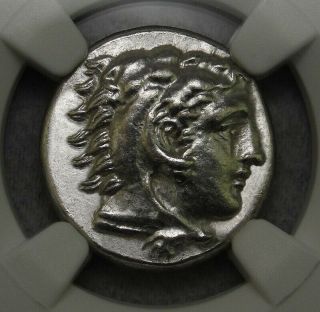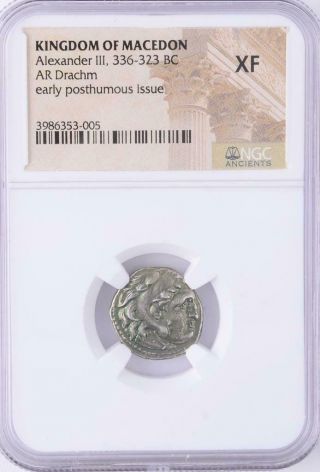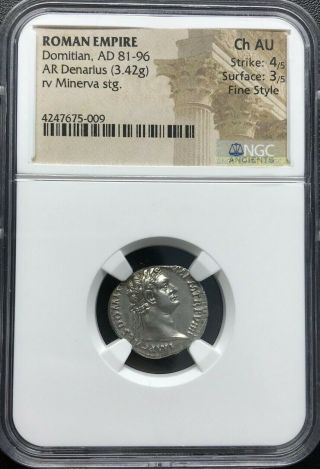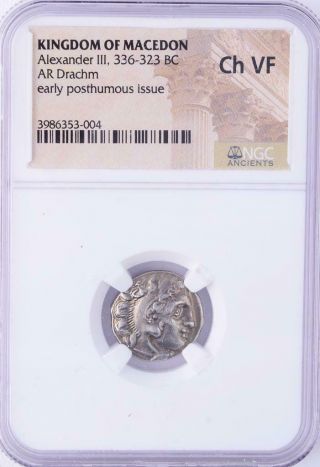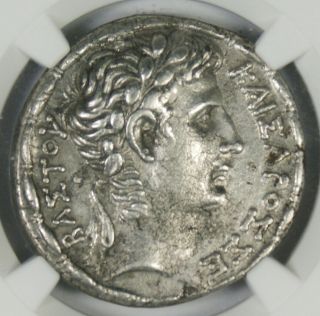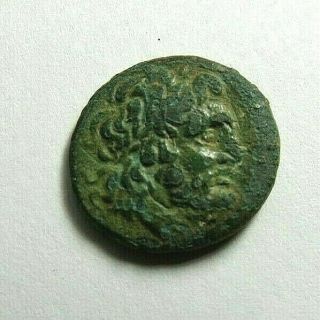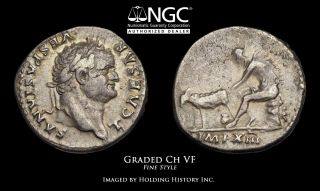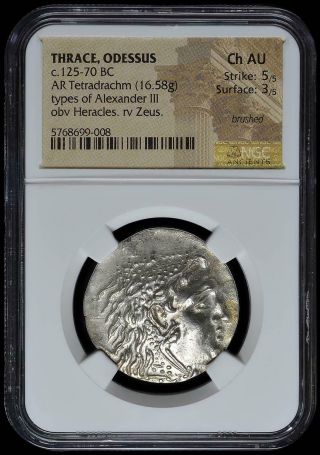NGC CH AU FINE STYLE Alexander The Great Drachma. Spectacular Ancient Greek Coin
Item History & Price
AUTHENTICITY GUARANTEE FOR ETERNITY 30 DAYS RETURNS
Masterpiece drachma from Alexander the Great ( Alexander III of Macedon. )Head of Herakles right, wearing lion skin / Zeus Aëtophoros seated left;
Condition : NGC graded CH AU FINE STYLE (Choice Almost uncirculated)
The best ever reverse you might see, Zeus is highly artistic and under eagle is the Olympic games Torch.
FINE STYLE doubles down in Rarity. These type of dies were us...ed only for special events like Triumph for a General, Rome's birthday celebrations with Games , or Victory in a decisive battle.These dies were minted in very limited numbers therefore very few coins survived.
Alexander the Great Death.
There are many theories about his mysterious illness however, symptoms and time course of Alexander's disease are inconsistent with influenza, as well as with malaria however They are exact match for a poisonous plant very well known in Greece "Veratrum album" The only reason he had a prolonged death and " HISTORIANS ARE MISSING THIS VERY IMPORTANT DETAIL " His mother Olympias made him immune from various snake poisons giving him small doses since he was a child. Yes he was immune to venom that gave him more stamina against Veratrum Album or as we know Hellebore. However whoever did it, gave him a second dose . Greeks kept dry roots of this plant just for taking care of enemies. Alexander himself had a little chest with this dry roots of Hellebore. The best answer comes from Emperor Claudius saying. ( if you want to find the culprit ask the question " quo beneficti ad primerum " who benefits first)
Who did it?By contrast many Greek and Roman writers were certain they knew not only who did it, but how and with what poison. With remarkable uniformity they pointed their fingers at Antipater, the senior general whom Alexander had left in charge of the Macedonian homeland, and at two of his sons, Cassander and Iollas.
Antipater may indeed have had reason to want Alexander dead in the spring of 323 BC, for the king had just removed him from his post and summoned him to Babylon, perhaps with hostile intent. Antipater stayed put but sent Cassander in his stead. According to several ancient accounts Antipater sent with his son a draught of toxic water, collected from the legendary river Styx, (believed to flow above ground in the northern Peloponnese before plunging down into the underworld). banks of it are full with overgrown Hellebore.The water had to be transported in a hollowed-out mule’s hoof, for it was said to eat right through any other substance but horn. Cassander passed this mule’s hoof to his brother Iollas – conveniently enough, Alexander’s wine-pourer – who then slipped the toxin into the king’s drink.Alexander was first stricken in the midst of the drinking party rather than afterward and, more importantly, just as he drained a huge cup of wine. These accounts say that Alexander felt a stabbing sensation in the back after downing the cup and cried aloud. From that point on these sources record a variety of symptoms, including great pain, convulsions and delirium.The basic elements of this story are the same in every ancient retelling One very early version, published in an anonymous Greek pamphlet, now known as The Last Days and Testament of Alexander, made Iollas doubly guilty: when the first draught of poison failed to kill Alexander, Iollas administered a second dose, soaking in Styx water the feather he used to help the king vomit.
References from :
1. Jona Lendering. "Death in Babylon". Livius . Aug 22, 2011.2. Alexander and the Chaldaeans". Livius. . Aug 22, 2011.3. Alexander the Great. Robin Lane Fox. 1973. p. 416.4. Yādnāmah-ʾi Panjumīn Kungrih-ʾi Bayn al-Milalī-i Bāstānshināsī va Hunar-i Īrān. Ministry of Culture and Arts, Iran. Vizārat-i Farhang va Hunar. 1972. p. 224.5. The Sháhnáma of Firdausí By Arthur George Warner, Edmond Warner. 2001. p. 61. 6. The Cambridge History of Hellenistic Philosophy edited by Keimpe Algra. 1999. p. 243.7. History of Philosophy By Silvano Borruso. 2007. p. 50.8. My library My History Books on Google Play National Geographic, Volume 133. 1968. p. 64.9. National Geographic , Volume 133. 1968. p. 64.10. The philosophical books of Cicero. Duckworth. 1989. p. 186.11. Carlos G. Musso. "MEGAS ALEXANDROS (Alexander The Great ): His Death Remains a Medical Mystery". Humane Medicine Health Care. Aug 21, 2011.12. John S. Marr; Charles H. Calisher. "Alexander the Great and West Nile Virus Encephalitis". CDC. Aug 21, 2011.13. Disease, not conflict, ended the reign of Alexander the Great". The Independent on Sunday. Aug 21, 2011.14. Machiavelli, Niccolo. "The Prince". Bartleby. Retrieved 6 April 2016.15. Schep LJ, Slaughter RJ, Vale JA, Wheatley P (January 2014). "Was the death of Alexander the Great due to poisoning? Was it Veratrum album?". Clinical Toxicology. 52 (1): 72–7. doi:10.3109/15563650.2013.870341. PMID 24369045.16. Bennett-Smith, Meredith (14 January 2014). "Was Alexander The Great Poisoned By Toxic Wine?".
Alexander the Great with idiopathic Scoliosis (Ιδιοπαθής σκολίωση)
Physical depictions of this historical figure reveal the likelihood of a cervical scoliotic deformity. It has been discussed that Alexander had structural neck deformities and oculomotor deficits, and this could be associated with Klippel-Feil Syndrome, a rare congenital scoliotic disorder. Some believe that as Alexander fell ill in his final days, he suffered from progressive epidural spinal cord compression, which left him quadriplegic.Little is known about the history of spinal deformities in ancient Greece. The present study summarizes what we know today for diagnosis and management of spinal deformities in ancient Greece, mainly from the medical treatises of Hippocrates and Galen. Hippocrates, through accurate observation and logical reasoning was led to accurate conclusions firstly for the structure of the spine and secondly for its diseases. He introduced the terms kyphosis and scoliosis and wrote in depth about diagnosis and treatment of kyphosis and less about scoliosis. The innovation of the board, the application of axial traction and even the principle of trans-abdominal correction for correction of spinal deformities have their origin in Hippocrates. Galen, who lived nearly five centuries later impressively described scoliosis, lordosis and kyphosis, provided aetiologic implications and used the same principles with Hippocrates for their management, while his studies influenced medical practice on spinal deformities for more than 1500 years.------Figure 3A marble statue of Alexander the Great, showing a characteristic body asymmetry in the axis of the head, shoulders and neck, Istanbul, Turkey.
Please note: Pictures are taken with an amateur camera and are much more beautiful in person.
-------------------------------------------------------------------------------------------------------
If you want a COA for your coins, you can order them after the auction.We give COA, only for coins sold in our store.Our Elaborate COA comes with 24 karat Gold seal on top.It has detailed Description/ Provenance and history of the coin. Order the COA from our fixed price COA listing, this way you get combined shipping.
--------------------------------------------------------------------------------------------------------
Do not spend a lot of money in big auction houses where you have to pay outrageous buyer's fees, reserve prices and shill bidding.Buy from us, we offer coins for a fraction of real prices
Visit Our Store: ancientcoins.market
00669
Masterpiece drachma from Alexander the Great ( Alexander III of Macedon. )Head of Herakles right, wearing lion skin / Zeus Aëtophoros seated left;
Condition : NGC graded CH AU FINE STYLE (Choice Almost uncirculated)
The best ever reverse you might see, Zeus is highly artistic and under eagle is the Olympic games Torch.
FINE STYLE doubles down in Rarity. These type of dies were us...ed only for special events like Triumph for a General, Rome's birthday celebrations with Games , or Victory in a decisive battle.These dies were minted in very limited numbers therefore very few coins survived.
Alexander the Great Death.
There are many theories about his mysterious illness however, symptoms and time course of Alexander's disease are inconsistent with influenza, as well as with malaria however They are exact match for a poisonous plant very well known in Greece "Veratrum album" The only reason he had a prolonged death and " HISTORIANS ARE MISSING THIS VERY IMPORTANT DETAIL " His mother Olympias made him immune from various snake poisons giving him small doses since he was a child. Yes he was immune to venom that gave him more stamina against Veratrum Album or as we know Hellebore. However whoever did it, gave him a second dose . Greeks kept dry roots of this plant just for taking care of enemies. Alexander himself had a little chest with this dry roots of Hellebore. The best answer comes from Emperor Claudius saying. ( if you want to find the culprit ask the question " quo beneficti ad primerum " who benefits first)
Who did it?By contrast many Greek and Roman writers were certain they knew not only who did it, but how and with what poison. With remarkable uniformity they pointed their fingers at Antipater, the senior general whom Alexander had left in charge of the Macedonian homeland, and at two of his sons, Cassander and Iollas.
Antipater may indeed have had reason to want Alexander dead in the spring of 323 BC, for the king had just removed him from his post and summoned him to Babylon, perhaps with hostile intent. Antipater stayed put but sent Cassander in his stead. According to several ancient accounts Antipater sent with his son a draught of toxic water, collected from the legendary river Styx, (believed to flow above ground in the northern Peloponnese before plunging down into the underworld). banks of it are full with overgrown Hellebore.The water had to be transported in a hollowed-out mule’s hoof, for it was said to eat right through any other substance but horn. Cassander passed this mule’s hoof to his brother Iollas – conveniently enough, Alexander’s wine-pourer – who then slipped the toxin into the king’s drink.Alexander was first stricken in the midst of the drinking party rather than afterward and, more importantly, just as he drained a huge cup of wine. These accounts say that Alexander felt a stabbing sensation in the back after downing the cup and cried aloud. From that point on these sources record a variety of symptoms, including great pain, convulsions and delirium.The basic elements of this story are the same in every ancient retelling One very early version, published in an anonymous Greek pamphlet, now known as The Last Days and Testament of Alexander, made Iollas doubly guilty: when the first draught of poison failed to kill Alexander, Iollas administered a second dose, soaking in Styx water the feather he used to help the king vomit.
References from :
1. Jona Lendering. "Death in Babylon". Livius . Aug 22, 2011.2. Alexander and the Chaldaeans". Livius. . Aug 22, 2011.3. Alexander the Great. Robin Lane Fox. 1973. p. 416.4. Yādnāmah-ʾi Panjumīn Kungrih-ʾi Bayn al-Milalī-i Bāstānshināsī va Hunar-i Īrān. Ministry of Culture and Arts, Iran. Vizārat-i Farhang va Hunar. 1972. p. 224.5. The Sháhnáma of Firdausí By Arthur George Warner, Edmond Warner. 2001. p. 61. 6. The Cambridge History of Hellenistic Philosophy edited by Keimpe Algra. 1999. p. 243.7. History of Philosophy By Silvano Borruso. 2007. p. 50.8. My library My History Books on Google Play National Geographic, Volume 133. 1968. p. 64.9. National Geographic , Volume 133. 1968. p. 64.10. The philosophical books of Cicero. Duckworth. 1989. p. 186.11. Carlos G. Musso. "MEGAS ALEXANDROS (Alexander The Great ): His Death Remains a Medical Mystery". Humane Medicine Health Care. Aug 21, 2011.12. John S. Marr; Charles H. Calisher. "Alexander the Great and West Nile Virus Encephalitis". CDC. Aug 21, 2011.13. Disease, not conflict, ended the reign of Alexander the Great". The Independent on Sunday. Aug 21, 2011.14. Machiavelli, Niccolo. "The Prince". Bartleby. Retrieved 6 April 2016.15. Schep LJ, Slaughter RJ, Vale JA, Wheatley P (January 2014). "Was the death of Alexander the Great due to poisoning? Was it Veratrum album?". Clinical Toxicology. 52 (1): 72–7. doi:10.3109/15563650.2013.870341. PMID 24369045.16. Bennett-Smith, Meredith (14 January 2014). "Was Alexander The Great Poisoned By Toxic Wine?".
Alexander the Great with idiopathic Scoliosis (Ιδιοπαθής σκολίωση)
Physical depictions of this historical figure reveal the likelihood of a cervical scoliotic deformity. It has been discussed that Alexander had structural neck deformities and oculomotor deficits, and this could be associated with Klippel-Feil Syndrome, a rare congenital scoliotic disorder. Some believe that as Alexander fell ill in his final days, he suffered from progressive epidural spinal cord compression, which left him quadriplegic.Little is known about the history of spinal deformities in ancient Greece. The present study summarizes what we know today for diagnosis and management of spinal deformities in ancient Greece, mainly from the medical treatises of Hippocrates and Galen. Hippocrates, through accurate observation and logical reasoning was led to accurate conclusions firstly for the structure of the spine and secondly for its diseases. He introduced the terms kyphosis and scoliosis and wrote in depth about diagnosis and treatment of kyphosis and less about scoliosis. The innovation of the board, the application of axial traction and even the principle of trans-abdominal correction for correction of spinal deformities have their origin in Hippocrates. Galen, who lived nearly five centuries later impressively described scoliosis, lordosis and kyphosis, provided aetiologic implications and used the same principles with Hippocrates for their management, while his studies influenced medical practice on spinal deformities for more than 1500 years.------Figure 3A marble statue of Alexander the Great, showing a characteristic body asymmetry in the axis of the head, shoulders and neck, Istanbul, Turkey.
Please note: Pictures are taken with an amateur camera and are much more beautiful in person.
-------------------------------------------------------------------------------------------------------
If you want a COA for your coins, you can order them after the auction.We give COA, only for coins sold in our store.Our Elaborate COA comes with 24 karat Gold seal on top.It has detailed Description/ Provenance and history of the coin. Order the COA from our fixed price COA listing, this way you get combined shipping.
--------------------------------------------------------------------------------------------------------
Do not spend a lot of money in big auction houses where you have to pay outrageous buyer's fees, reserve prices and shill bidding.Buy from us, we offer coins for a fraction of real prices
Visit Our Store: ancientcoins.market
00669



